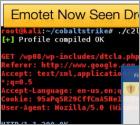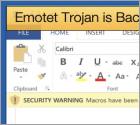Internet threat news

The US Treasury Department announced that the department had sanctioned four Ukrainian individuals under suspicion that they had “engaged in Russian government-directed influence activities to destabilize Ukraine”. These efforts are believed to be done with the view of assisting any military effort to control Ukrainian critical infrastructure for the benefit of Russia.
The Treasury Department's Office of Foreign Assets Control (OFAC) issued sanctions against Taras Kozak, Oleh Voloshyn, Volodymyr Oliynyk, and Vladimir Sivkovich. Those accused are either current or former Ukrainian officials ordered to gather information and spread disinformation.

Since the middle of December 2021, a new ransomware strain seemed to have emerged. Initially, famed ransomware hunter and researcher Michael Gillespie took to Twitter to see if anyone had managed to get a sample of the strain now called White Rabbit, which certainly would have picked up the ears of any Matrix fans despite the bashing the last film received.

A group of cybersecurity researchers at Intezer have discovered a new malware strain that is capable of creating backdoors on Windows, Mac, and Linux machines. The malware was discovered in December 2021 and hints at a trend of new malware being developed that is capable of targeting multiple operating systems.

Towards the end of the holiday season Portland, Oregon-based brewery McMenamins confirmed it had suffered a ransomware attack dating back to December 12, 2021. On December 16, 2021, Bleeping Computer reported that the Brewery has suffered a ransomware incident.

In the NCC Groups monthly threat pulse article it was discovered that the Pysa ransomware strain took the dubious honor of becoming one of the most prolific ransomware strains for the month of November. Attacking businesses has always been on the agenda for those behind Pysa, in the past the publication covered how the gang was targeting organizations within the education sector.

What is rapidly turning into one of the major InfoSec talking points for the year the threat posed by potential exploitation of the Log4j2 flaw is increasing exponentially for those who have not patched the popular logging application. In our previous coverage we detailed how threat actors distributing botnets, remote access trojans, coin miners, and ransomware were already weaponizing the flaw. Now, as predicted nation-state threat actors are looking to do the same.

With the public release of information regarding vulnerability CVE-2021-4428, also known as Log4j2 or Log4Shell, on December 10, 2021, many can be forgiven just letting the news pass by. For players of videogames in the 90s, Log4j2 resembles a save code or even worse a cheat code for a pixel-defined game.

Recently the potential dangers of online shopping were made apparent over the recent Black Friday period. As soon as that ended the Christmas shopping spree began, and another discovery by security firm Sucuri again shows the dangers of online shopping to both consumers and retailers.
According to a recent article published on Securi’s blog, researchers have discovered card skimming malware being injected into WooCommerce plugins.

In November 2021 this publication covered the return of Emotet after law enforcement agencies around the globe worked to cease the malware’s operations by seizing critical infrastructure. Since the return of the botnet, it has been incredibly active being distributed in several campaigns. Now researchers have seen the Botnet dropping the infamous penetration testing tool Cobalt Strike in an attempt to fast forward ransomware attacks.

According to a new report published by Threat Fabric, several malware distribution campaigns have infected almost 300,000 Android users. Infections were carried out by users downloading malicious apps from the Google Play Store containing malware droppers which would then drop banking trojans specifically designed for harvesting and stealing banking credentials.
The theft of credentials is primarily done via a fake banking login page that overlays a legitimate one. Threat actors then exfiltrate the credentials and either sell them on underground marketplaces or use the credentials to commit various kinds of banking fraud. While this phenomenon is certainly not new the tactics used, namely the evolution of past tactics is what has piqued the researcher’s interest in the campaigns.

To say that the cryptocurrency market, now valued at 2.5 trillion USD, has seen its fair share of scams would be an understatement. The latest to affect the cryptocurrency and Non-Fungible Token (NFT) community involves a threat actor targeting enthusiasts on the popular messaging platform Discord.
According to an article published by security firm Morphisec, Discord is being used to distribute crypter malware. Crypter malware can be seen as a specific type of malware that can encrypt, obfuscate, and manipulate malware, to make it harder to detect by security programs. They are typically used by threat actors to pass off malware as legitimate and non-harmful software applications. Crypters broadly come in two forms, static or polymorphic.

The UK’s National Cyber Security Centre (NCSC) was issued a warning noting that a total of 4,151 retailers had been compromised by hackers attempting to exploit vulnerabilities on checkout pages to divert payments and steal details. The retailers impacted have been informed about the vulnerabilities customers are falling victim to over the past 18 months.
According to the warning the majority of victims were impacted by hackers exploiting known vulnerabilities in the e-commerce platform Magento. The vulnerabilities when properly exploited allow the attacker to steal credit card information entered by the customer as well as possibly redirect payments to attacker-controlled bank accounts.

Once referred to as the “world’s most dangerous malware,” after almost a year hiatus Emotet is back. This is not the first time the infamous botnet has resurfaced after a long hiatus.
This time the reemergence of the botnet has happened after significant law enforcement efforts bring down the botnet’s infrastructure.

Europol recently published their Internet Organised Crime Threat Assessment report for 2021 which highlights several trends relating to cyber threats, with ransomware yet again featuring prominently in their research. The report notes, among several other trends, that ransomware reports have increased over the 12 month reporting period looked into by the law enforcement organization and that Distributed Denial of Service (DDoS) attacks, or the threat thereof, are being used to place further pressure on victims.
More Articles...
Page 9 of 52
<< Start < Prev 1 2 3 4 5 6 7 8 9 10 Next > End >>